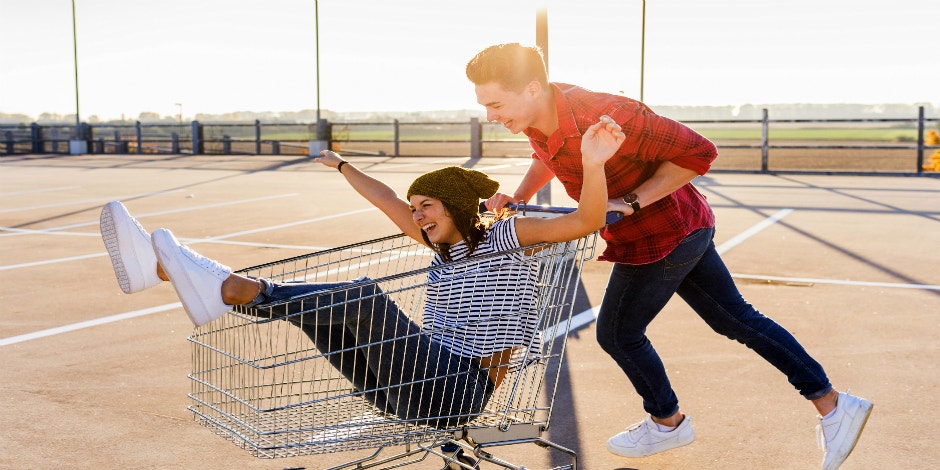The Best Feeling In The World Is Laughing With Someone You Love
Especially when you see them laugh too.
 getty
getty Research shows that when we are at play and are demonstrating how to be happy, our brains release a stream of soothing, pleasure-producing opioids — better known as endorphins — into our nervous system.
While these opioids belong to the same family as heroin, methadone and morphine, they are naturally produced by our own bodies, giving us a similar "high," without that nasty addiction after-taste. In fact, when we need it to, our brain produces opioids that are 300 times more powerful than heroin!
How cool is that? It certainly explains a lot about the practically non-stop happiness we associate with little children and young animals. We release opioids both when we feel joy and when we need to dampen pain.
Scientists talk about such pain as down-regulation. As soon as the brain receives a signal that the body is in pain, the signals to down-regulate begin. Laughter (and the benefits of laughter) works in much the same way, because it is the result of our basic instinct to seek, nurture and play with others in "high arousal" moments.
Have you noticed that when you see a small child, they are either bent over in hysterical glee, or crying their eyes out as though the world is coming to an immediate end? As opposite as they may seem, our expressions of emotion through laughing and crying share many of our brain and body systems.
From as young as two months old, humans need play in order to inform our perceptions of the world. Infants that age learn mainly during face-to-face play with their parents and other caregivers. The enjoyment of this play and the distress of separation form our patterns of attachment.
During the highly charged events, babies laugh or cry and make faces in an attempt to soothe themselves by sharing an expression of how they feel with another person.
In order to practice and learn from these behaviors in a healthy ways, we first and foremost have to feel safe. When a parent and a baby laugh together, they are co-regulating their opioid systems by creating a shared state of positive arousal and pleasurable feelings.
Amazing! All that energy flowing back and forth builds new pathways in both of their bodies and brains as they strengthen each other's existing emotional patterns. When you laugh joyously, you feel safer in the world. You also feel more adventurous.
Our deep wiring sends us in search of new situations (as well in search of shelter when we become afraid). Mammal life is organized around foraging, hunting, mating, comfort-seeking, playing and nurturing. Seeking these things is vital to our survival, both individually and as a species.
Play is an opportunity for our children to explore adult behaviors they will need to master in order to survive. This is especially true of rough-and-tumble play, touch, and laughter.
According to researchers Jaak Panksepp and Lucy Bivens, “Laughter, like playfulness itself, is an unconditional instinctive response that arises, under the right social-environmental conditions, from ancient regions of the mammalian brain."
When you become energized enough to laugh, you generate more energy and — strange as it sounds — more calmness. Animals who have learned how much fun it is to be tickled begin to seek out this kind of stimulation. They'll start laughing, chirping, or squeaking when they receive cues they are about to be tickled.
Remember those opioids? The high levels lingering in our brain following laughter both increase our feelings of social confidence and reduce our feelings of separation anxiety. The "warm fuzzies" teach us to worry less about others not liking us, because people like to be around people who make them feel happy.
When a two-month-old baby cries and laughs out loud to maintain and expand contact and bonding between parent and child, a beautiful dance develops based on the rhythm of these noises. As the baby makes joyous sounds, we want to tickle them, inviting more playful noises and gestures. When the baby cries, we want to comfort them.
As we grow and develop more mature friendships, we learn to poke at their funny bone in more age-appropriate ways, sharing special laughs, inside jokes, and similar triggers for sadness and comfort.
So, laugh and cry with your friends and family. You will have more energy, and become more emotionally flexible. We grow when we learn to ride the waves of our emotions, so when you experience either sadness or joy, choose to surf along with the feelings on your way to increased energy and greater joy throughout your life.
Bill Maier is a psychotherapist in private practice in Portland, OR. He specializes in depression, PTSD, trauma, and addiction.

